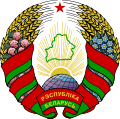
Belarusian heraldry
Encyclopedia

.svg.png)
History
The historyHistory
History is the discovery, collection, organization, and presentation of information about past events. History can also mean the period of time after writing was invented. Scholars who write about history are called historians...
of Belarus
Belarus
Belarus , officially the Republic of Belarus, is a landlocked country in Eastern Europe, bordered clockwise by Russia to the northeast, Ukraine to the south, Poland to the west, and Lithuania and Latvia to the northwest. Its capital is Minsk; other major cities include Brest, Grodno , Gomel ,...
ian heraldry
Heraldry
Heraldry is the profession, study, or art of creating, granting, and blazoning arms and ruling on questions of rank or protocol, as exercised by an officer of arms. Heraldry comes from Anglo-Norman herald, from the Germanic compound harja-waldaz, "army commander"...
is integral to that of the Szlachta
Szlachta
The szlachta was a legally privileged noble class with origins in the Kingdom of Poland. It gained considerable institutional privileges during the 1333-1370 reign of Casimir the Great. In 1413, following a series of tentative personal unions between the Grand Duchy of Lithuania and the Kingdom of...
, the Polish-Belarusian nobility
Nobility
Nobility is a social class which possesses more acknowledged privileges or eminence than members of most other classes in a society, membership therein typically being hereditary. The privileges associated with nobility may constitute substantial advantages over or relative to non-nobles, or may be...
. Until it was absorbed into the Soviet Union
Soviet Union
The Soviet Union , officially the Union of Soviet Socialist Republics , was a constitutionally socialist state that existed in Eurasia between 1922 and 1991....
, Belarus itself was represented by a coat of arms: a charging knight on a red field, called the Pahonia
Pahonia
The Pahonia , transliteration: Pahonya, , Lithuanian: Vytis, Pagaunė, is a historical symbol of Grand Duchy of Lithuania, of which the eastern part later became known as Belarus...
('the Chase').
With Communism, coats of arms fell out of favor and were replaced by emblems. The cities still used shields, but these were changed to add socialist realism or to announce the state awards each city earned.
Once the Soviet Union fell apart in 1991, the Pahonia was restored as the state coat of arms and the cities reverted to old coat of arms or created new designs. Each of the seven voblasts of Belarus has its own coat of arms. Historical achievements, state awards or state symbols are placed on the coat of arms. For example, the enterprise "October" features the state flag of Belarus on their coat of arms.http://www.oct.by/
See also
- Coat of ArmsCoat of armsA coat of arms is a unique heraldic design on a shield or escutcheon or on a surcoat or tabard used to cover and protect armour and to identify the wearer. Thus the term is often stated as "coat-armour", because it was anciently displayed on the front of a coat of cloth...
- HeraldryHeraldryHeraldry is the profession, study, or art of creating, granting, and blazoning arms and ruling on questions of rank or protocol, as exercised by an officer of arms. Heraldry comes from Anglo-Norman herald, from the Germanic compound harja-waldaz, "army commander"...
- History of BelarusHistory of BelarusThis article describes the history of Belarus. The Belarusian ethnos is traced at least as far in time as other East Slavs.After an initial period of independent feudal consolidation, Belarusian lands were incorporated into the Kingdom of Lithuania, Grand Duchy of Lithuania, and later in the...
- List of Belarusian Coats of Arms
- RutheniaRutheniaRuthenia is the Latin word used onwards from the 13th century, describing lands of the Ancient Rus in European manuscripts. Its geographic and culturo-ethnic name at that time was applied to the parts of Eastern Europe. Essentially, the word is a false Latin rendering of the ancient place name Rus...
- SzlachtaSzlachtaThe szlachta was a legally privileged noble class with origins in the Kingdom of Poland. It gained considerable institutional privileges during the 1333-1370 reign of Casimir the Great. In 1413, following a series of tentative personal unions between the Grand Duchy of Lithuania and the Kingdom of...
- Polish heraldryPolish heraldryPolish heraldry is a branch of heraldry focused on studying the development of coats of arms in the lands of historical Poland , as well as specifically-Polish traits of heraldry. The term is also used to refer to Polish heraldic system, as opposed to systems used elsewhere, notably in Western Europe...
- Belarusian nameBelarusian nameA modern Belarusian name of a person consists of three parts: given name, patronymic, and family name, similarly to names in other East Slavic cultures: Russian names and Ukrainian names.-Belarusian given names:...
Further reading
- Tadeusz GajlTadeusz GajlTadeusz Gajl is a Polish artist, notable for his study on Polish heraldry. After graduating from the Academy of Fine Arts in Łódź in 1966, he worked as a design specialist in a fabric factory in Białystok. Between 1975 and the Martial Law of 1981 he was working as artistic director of the...
, "Herby szlacheckie Rzeczypospolitej Obojga Narodow", GdańskGdanskGdańsk is a Polish city on the Baltic coast, at the centre of the country's fourth-largest metropolitan area.The city lies on the southern edge of Gdańsk Bay , in a conurbation with the city of Gdynia, spa town of Sopot, and suburban communities, which together form a metropolitan area called the...
, 2003

